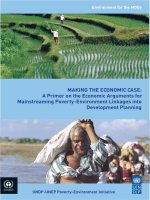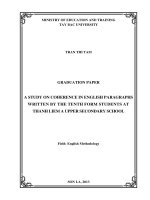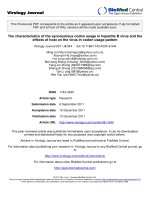Unit 4: Economic Reports Report on poverty in Vietnam Human development is the process of
Bạn đang xem bản rút gọn của tài liệu. Xem và tải ngay bản đầy đủ của tài liệu tại đây (39.09 KB, 4 trang )
Unit 4: Economic Reports
Page 38
Report on poverty in Vietnam
Widespread poverty: The most urgent human development challenge in Vietnam
Human development is the process of widening the opportunity for people to improve
their quality of life in a sustainable way. The poor in all societies often have the least
opportunity of choice for a variety of economic, social, cultural and political reasons.
There are reasons for this: There is not enough income to pay for food, nutrition and
housing in a decent way; do not have full access to child health and education services;
isolated from social and cultural life; no skills, knowledge and employment; as well as
many other difficult and restrictive.
Although Vietnam has made significant progress over the past 12 years, widespread
poverty and near-poverty remains the most pressing human development challenge in
Vietnam, particularly in rural areas, where 80% of the population and 90% of the poorest
people live. Vietnam's per capita income is the lowest in the world, at about $ 310 a year
nationwide in general and less than $ 200 a year in rural areas in particular. Therefore,
most Vietnamese people are living in poverty.
This report suggests several frameworks for human development and broadening the
selection opportunities for the poorest and most vulnerable groups, especially in rural
areas.
Many achievements have been made in human development during the renovation
process
The renovation process that began in 1986 has so far made significant progress in
expanding the opportunities of choice and improving the quality of life for the
Vietnamese people.
According to recent preliminary statistics of the living standard survey currently
underway with the support of Sweden, the World Bank and UNDP, today hunger has
declined from more than 70 percent in the middle the 1980s were down to approximately
30 percent. The average life expectancy was 66 years. Adult literacy rates are maintained
at over 90 percent. Per capita income has nearly doubled. Infant mortality has dropped to
45/1,000.
Actual spending on the social sector now exceeds the highest levels previously. More and
more people have access to clean water supply, sanitation and health care services. In
summary, all the statistics and evidence available now show that the change has
significantly improved the quality of life for the vast majority of the people of Vietnam.
Innovation: A successful process of expanding opportunities for people to choose
Most of the innovations are based on the expansion of people's choices and participation
opportunities in many areas, especially in the non-state sector. Land management
innovations in the latter half of the 1980s increased the opportunities for rural families to
use and manage agricultural land most effectively. As a result, rice production has
skyrocketed and Vietnam has moved from a large rice importer in the mid-1980s into the
world's second largest rice exporter. In addition, farmers have diversified into higher
value crops such as tea, coffee, rubber and other crops.
Similarly, market and price liberalization have expanded the range of choices in the areas
of production, employment and consumption. Open door policy in the process of
innovation has enhanced international trade and the opportunity to choose the type and
quantity of goods and services to improve the quality of life for all Vietnamese people.
Foreign investment has expanded the choice of technology and employment
opportunities. These innovations and other policy reforms have greatly enhanced the
opportunity for people to choose and help many poor families escape poverty and
improve their lives significantly.
Human development in interim period: Many challenges still exist.
However, conditions of poverty and poverty threshold are still common in Vietnam. The
per capita income is one of the lowest in the world and most of Vietnamese live in
conditions of poverty or almost such. The weaknesses is immanent in economic structure
still haven't surmounted yet while negative effects of area crisis correctly are became
more seriously. In such a situation, to maintain and promote recent achievements in the
field of hunger eradication and poverty alleviation and human development, obviously, it
is still necessary to proceed economic - society reform measures in the coming years.
Apart from income, many other indicators of human development such as infant
mortality rates, nutrition, lifespan, family planning measures, male-female equality and
other indicators clearly need to be improved more based on the global human
development index calculated on the basis of national performance on life, education and
income, Vietnam ranks 122nd out of 174 countries in the world.
Continue proceed economic-society reform is an important factor in achieving the
government's society's-economic goals.
The government expects poverty alleviation in the next few years and the current poverty
situation in 2010, while also striving to increase real income per capita income by 8 to 10
times by 2020, Equality, stability and sovereignty. These targets are high but can be
implemented in an effective policy environment and with poverty reduction measures.
It is necessary to continue to innovate to further expand the opportunities for people
to get out of poverty
Lessons learned from the process of implementing the reform in Vietnam in the past 12
years and impressive achievements in poverty reduction show that further expansion of
selection opportunities for the district Non-state sector is very necessary. Continuing to
strengthen the innovation process in both depth and breadth will create enormous
potential for sustainable human development and poverty reduction.
It is particularly important to increase the accessibility of rural poor households to
knowledge and information as well as their participation in public spending and local
decision-making. In the countryside, timely information on the market volatility of
agricultural and non-agricultural products will facilitate better production planning,
marketing and consumption product. Increasing publicity in local government decisionmaking and budget spending will encourage more efficient investments in rural
infrastructure construction, while significantly reducing wasteful state.
It is important to improve rural infrastructure, especially roads, in order to reduce
establishment and increase access to markets, employment opportunities and social
services. It is necessary to apply a more liberal interest rate policy in small-scale credit to
the poor to increase the accessibility of the poor.
Improving family planning measures will also extend many opportunities for women to
better protect their health and prevent unwanted child or child poverty. It is important to
strengthen the stability of laws and regulations to reduce uncertainties, enabling people to
more accurately predict the results they will gain from their choice and reduce anxiety as
the risks in deciding on those choices.
More direct measures are needed for poverty reduction and human development
As a low-income country, it is unrealistic to expect Vietnam to build a solid social
welfare and welfare system soon.
However, there is a need to redistribute the current social spending target to focus more
on health and education in the poorest communities and districts.
The social security system like this will grow and grow with the economy in general. The
central government needs to manage very closely to ensure that state allocations to
provinces for distribution to the social sector are distributed to the poorest communes by
the provincial government and easier to influence. The plan to support 1,715 of Viet
Nam's poorest communes recently published by the Government will create great
potential for improving the living standards of the poorest of Vietnam.









